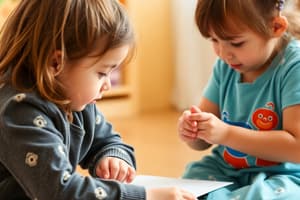Podcast
Questions and Answers
What is the primary goal of adjusting and rearranging the learning space?
What is the primary goal of adjusting and rearranging the learning space?
- To provide opportunities for children to express their interests and needs (correct)
- To strictly control the number of children playing in a particular area
- To create a perfect environment for children to play and learn
- To ensure that children are not using challenging behavior
Why do children use challenging behavior?
Why do children use challenging behavior?
- Because they are not interested in learning
- To test the boundaries of the environment
- To communicate that the environment is not working well for them (correct)
- To get attention from the teachers
What is the importance of having multiple instances of popular items in the learning space?
What is the importance of having multiple instances of popular items in the learning space?
- To create a sense of scarcity among children
- To allow children to explore different materials
- To reduce conflicts among children (correct)
- To encourage children to share
What is the role of the physical environment in early childhood education?
What is the role of the physical environment in early childhood education?
What is the benefit of providing children with tasks that offer a bit of challenge?
What is the benefit of providing children with tasks that offer a bit of challenge?
What is the purpose of integrating different learning areas in the learning space?
What is the purpose of integrating different learning areas in the learning space?
Why is it important to have the right amount of materials in the learning space?
Why is it important to have the right amount of materials in the learning space?
What is the role of the teacher in creating an effective learning environment?
What is the role of the teacher in creating an effective learning environment?
Why is it important to make adjustments to the learning space based on the children's behavior?
Why is it important to make adjustments to the learning space based on the children's behavior?
What is the relationship between the learning environment and children's behavior?
What is the relationship between the learning environment and children's behavior?
Flashcards are hidden until you start studying
Study Notes
Supporting Children with Challenging Behaviors
- Challenging behaviors in educational settings, particularly in preschools, require a thoughtful, informed, and compassionate approach.
- Challenging behaviors can manifest as aggression, defiance, hyperactivity, and social withdrawal, among others, and often signal underlying issues that need to be addressed.
Understanding Challenging Behaviors
- Challenging behaviors are often expressions of unmet needs, such as the need for attention, autonomy, sensory stimulation, or help in dealing with emotions.
- Understanding the context and triggers of these behaviors is crucial for addressing them effectively.
- Challenging behaviors can be both internalizing (e.g., crying, hiding, refusing to participate) and externalizing (e.g., aggression, defiance).
Teacher's Role in Managing Challenging Behaviors
- Teachers play a big role in how others perceive a child's use of challenging behaviors.
- Teachers can frame responses to difficult behaviors in a guiding way, providing learning opportunities for everyone, or they can unintentionally ostracize a child.
- A teacher's perception of why children do what they do is important; if they think about behavior as communication or a child's way of getting a need met, they can help the child find a better solution.
Strategies for Supporting Children with Challenging Behaviors
- Identify triggers: establishing a consistent routine and clear rules can reduce anxiety and uncertainty, which are common triggers for challenging behaviors.
- Teach emotional regulation skills: helping children identify, understand, and express their feelings in healthy ways can significantly reduce instances of challenging behavior.
- Ensure all children feel seen, heard, and valued: promoting diversity, equity, and inclusion in the classroom can help build a sense of community and reduce conflicts.
- Develop a behavior management plan: clearly defining expected behaviors, consequences, and involving the child in the planning process can help guide children towards better behaviors.
- Collaborate with parents and professionals: sharing observations and strategies can provide a more comprehensive understanding of the child's needs and behaviors.
Goal Setting and Measurement
- Setting goals helps integrate feelings, interpretations, and expectations into a single plan that can be consistently implemented by everyone involved.
- SMART guidelines can be used to develop an effective plan and evaluate its progress: Specific, Measurable, Achievable, Relevant, and Time-limited.### Understanding Behavior and Goals
- Defining behavior is crucial in understanding how to measure and change it.
- Setting goals is important in behavior management, and they should be specific, measurable, achievable, relevant, and time-bound (SMART).
- Goals should be focused on building skills, rather than eliminating challenging behaviors.
Teaching Alternative Behaviors
- Teaching alternative behaviors is essential for children who need explicit guidance on how to express their needs or frustrations.
- Role-playing, social stories, and modeling appropriate behaviors are effective tools in teaching alternative behaviors.
- Role-playing allows children to practice responding to various situations in a controlled setting.
- Social stories are short narratives or visual aids that depict specific situations and show step-by-step responses to those situations.
- Modeling involves an adult demonstrating positive ways to manage emotions and ask for help.
Using Positive Reinforcement
- Positive reinforcement is a highly effective strategy in encouraging and maintaining good behavior in children.
- Recognizing and rewarding positive behavior immediately makes it more likely that the child will repeat it in the future.
- Rewards should be meaningful to the child and appropriate to the behavior.
- Consistency is key in applying positive reinforcement, and all caregivers and educators involved with the child should apply it in the same way.
Implementing Supportive Disciplinary Techniques
- Implementing supportive disciplinary techniques shifts the focus from punishment to teaching and guiding children towards better behavior management.
- Techniques such as time-in, natural consequences, and logical consequences can be used to help children learn from their actions and improve future behaviors.
- Time-in involves the child spending time with an adult to calm down and discuss their feelings and behaviors.
- Natural consequences allow children to experience the consequences of their actions directly.
- Logical consequences are designed to relate directly to the behavior.
Collaborating with Parents and Professionals
- Collaborating with parents and professionals is crucial in successfully managing challenging behaviors in children.
- Regular and open communication with parents is important in sharing positive developments and collaborating on strategies.
- Involving professionals such as pediatricians, psychologists, and special education experts can provide a more informed approach to managing challenging behaviors.
- A unified and coherent strategy should be created to ensure consistency across all settings.
Providing Emotional Support and Skill Building
- Providing emotional support and building emotional regulation skills are critical components in helping children manage their behaviors effectively.
- Teaching children to identify and express their emotions can help them learn to handle their feelings in healthier ways.
- Emotion regulation techniques such as deep breathing, counting to 10, or engaging in a brief physical activity can help calm children's bodies and minds.
- Role-playing can be used to practice expressing emotions and using regulation techniques.
Adjusting the Learning Environment
-
Adjusting the learning environment can significantly influence children's behavior.
-
Reducing overstimulation, increasing physical activity, and creating quiet areas can help manage and even preempt behavioral issues.
-
Flexible seating options and layouts can provide children with choices that can help them feel more comfortable and engaged.
-
Adapting the physical layout of the classroom can facilitate better concentration and interaction among students.### Creating a Well-Organized Classroom Environment
-
A well-organized classroom environment is crucial for young children, as it helps them feel more comfortable and confident.
-
Busy environments can be overwhelming for children, leading to negative responses.
Minimizing Overstimulation
- Environments with too many elements can lead to exhaustion and stress for both children and adults.
- It's essential to identify and remove elements that cause fatigue and overwhelm.
Organizing Spaces and Materials
- A well-defined classroom should have materials where children need them, making it easier for them to access and use them.
- Examples of well-organized spaces include:
- Art area near the sink.
- Snack area near the sink.
- Dramatic play area with necessary materials, such as pencils and paper.
Predictability and Flexibility
- Children benefit from predictable spaces that are easily understood, allowing them to make their own decisions.
- A flexible environment that can adapt to children's needs is essential for their growth and development.
Empowering Children
- A well-organized classroom environment empowers children to make their own plans and choices about how to use materials.
- This approach helps children feel more in charge of their learning.
Setting Expectations and Challenging Children
- Providing opportunities for children to be challenged is essential for their growth and development.
- Setting expectations that are too high can lead to frustration and annoyance in children.
Growing Children's Capabilities
- Providing materials that are slightly above children's current level of development can help them grow and succeed.
- It's essential to shape environments and provide materials that help children succeed in a thoughtful and intentional way.
Adjusting the Environment
- Teachers should be willing to make adjustments to the environment based on the interests and needs of the children.
- Children often communicate through their behavior about whether the environment is working well for them.
Importance of Sharing and Having the Right Materials
- Providing multiple instances of popular materials can help children learn to share and reduce conflicts.
- Having the right amounts of materials is essential for a well-organized classroom environment.
Learning from Mistakes
- It's essential to learn from mistakes and make adjustments to the environment as needed.
- Focusing on what works well and building on that can help create a more effective and supportive learning environment.
The Environment as a Third Teacher
- The physical environment can have a significant impact on children's behavior and ability to learn.
- The environment should be seen as a third teacher, after the child's parents and classroom teacher, and should be carefully designed to support learning.
Studying That Suits You
Use AI to generate personalized quizzes and flashcards to suit your learning preferences.





